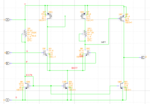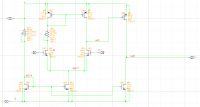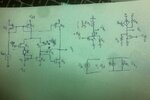thaintrinh
Junior Member level 1
Good afternoon.
I have been given a circuit like this: note that it has an additional resistor compared to the original one.

I believe this is a CMOS two stage amplifier in 0.8um technology.
I need to find out the operations, equivalent circuit and Av, Ai, Zin, Zout from this circuit. However, i can do the simulation for this circuit.
None of the documents on the internet seems to help. It would be very helpful if you can help me with this.
Thanks in advance
I have been given a circuit like this: note that it has an additional resistor compared to the original one.

I believe this is a CMOS two stage amplifier in 0.8um technology.
I need to find out the operations, equivalent circuit and Av, Ai, Zin, Zout from this circuit. However, i can do the simulation for this circuit.
None of the documents on the internet seems to help. It would be very helpful if you can help me with this.
Thanks in advance





